Abstract
Background: The aim of the work is to verify the usability of a stabilometric platform and audiovisual feedback in the group-based therapy of patients with vertebral algic syndrome, to analyze an immediate effect after a single therapeutic unit, and to analyze differences between male and female probands. Methods: The study included 189 patients (90 male, age 55 ± 12 and 89 female, age 52 ± 12). All patients received group balance therapy with a portable medical device, Homebalance MA. The intervention consisted of measurement of quiet stance and a reference training scene before and after 15 min of game-like balance training with audiovisual feedback. Results: A statistically significantly lower value of the body sway trajectory during quiet stance was detected in men than in women. After a single therapy session, there was a statistically significant improvement in quiet stance with visual feedback, and marginal statistically significant improvement in the time required to complete the reference training scene. Conclusions: Homebalance MA is a utilizable tool for group therapy. The use of group game-like balance training increases the availability of physiotherapeutic intervention for a larger number of patients, while maintaining the positive effect of the therapy.
1. Introduction
Three areas are important to ensure the physiological function of the spine: passive system (bone structure of spine, ligaments, tendons), active system (musculature), and motor control (peripheral and central nervous system). The interaction of these three systems allows the stability and the mobility of the spine and, hence, human movement against gravity.
Mechanisms of motor control, especially postural control, are currently being intensively investigated, particularly in the area of chronic back pain treatment. Changes in motor control, the reflex control of trunk muscles in patients with vertebral algic syndrome (VAS), in particular, have been documented in several studies [1,2]. Here, postural responses can be understood as complex activation patterns of the muscles of the trunk and limbs.
Of particular interest, in this context, is the early activation of trunk muscles, for which the activation of the sensory receptors of leg muscles and the plantar surface is very important. For this reason, postural stabilization training within the concept of multimodal pain therapy is one of the key therapeutic interventions in the rehabilitation of patients with vertebral algic syndrome (VAS).
An important neuroscience basis is in studies in which postural disorder in chronic back pain could be shown to be associated with plastic changes in the muscular representation of the trunk in the motor cortex [3,4]. Specific postural stability training could help to decrease these maladaptive neuroplastic changes, in addition to its peripheral effect on the passive and active spine system [5].
The high prevalence of VAS and the lack of effective primary care treatments lead to a decrease in the quality of life of patients, their families and community in a worldwide population [6]. Group-based multidisciplinary biopsychosocial rehabilitation has been reported to be effective for the treatment of VAS [7]. Interventions utilizing gaming technologies report strong retention and adherence rates, reduced perception of effort and fatigue, and increased enjoyment of exercise-related activities [8]. Coordination and stabilization exercise programs have a beneficial effect in the treatment of chronic back pain [9]. Devices originally designed for gaming consoles, such as Kinect motion sensor or stabilometric platform Nintendo Wii Balance Board (WBB), can be used for this purpose. Several studies have shown WBB is a valid tool for the quantification of postural stability [10]. The use of WBB and gamification of the therapy have a positive effect on decreasing vertebral pain [11]. Motivation and audiovisual feedback improve motor learning by providing exact tasks and giving feedback in real time. Thus, the physiotherapist can provide high-quality individual therapy to a larger group of patients at the same time.
Posturography can be combined with other methods, such as electroencephalography, electromyography, and heart rate detection, and visual feedback can be provided in virtual reality [12]. After classifying the signals and the output is also provided, the target device interprets and processes the orders [13]. Humans are able to reach and catch target objects, despite different circumstances, even if the object’s position changes [14]. The use of posturography combined with eye-tracking may be also a useful diagnostics method in patients suffering from abnormal eye movement (nystagmus) [15].
In a comparison of parameters of quiet stance in healthy adults aged 22–88 years, posturography showed highly significant positive correlations with age, both with subjects’ eyes open and with their eyes closed, with correlation coefficients slightly higher in the former, indicating an age-associated increase in swaying [16]. Elderly women show more severe impairments of balance when simultaneously deprived of visual and somatosensory inputs or during a backward destabilization than men [17]. Several studies detected the positive effect of game-like training with audiovisual feedback using WBB in patients with chronic stroke at the improvement of performance in gait (dynamic balance), but not in the other physical measures [18]. The aim of the work is to verify the usability of audiovisual feedback and WBB in the group-based game-like therapy of patients with VAS, to evaluate the therapeutic effect of the intervention, and to evaluate the influence of patients’ gender and age on their postural stability.
2. Materials and Methods
2.1. The Evaluated Technical Solution Homebalance MA
Homebalance MA is a medical device for the therapy of balance disorders. As the system is intended to be used also in group therapy and home-based therapy, it consists of low-cost, portable, and lightweight components. These components are a tablet with therapeutic software, an ergonomic tablet holder, and a stabilometric platform WBB. For patients with blurred vision the visual feedback can be presented on a bigger screen (Figure 1).
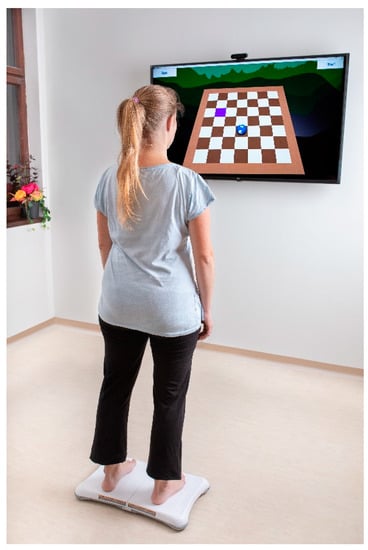
Figure 1.
Homebalance MA system.
Therapeutic software consists of 2 types of game-like therapeutic scenes. The therapy is based on the principle of audiovisual feedback. Standing on the WBB, the patient is instructed to move an item in the therapeutic game by shifting their center of pressure.
The position of the center of pressure is calculated from the load changes in four individual tensometers at the corners of the platform. The on-board processing unit acquires data at a rate of 100 Hz and sends the results in the form of datasets consisting of a load of tensometers and time stamps via Bluetooth to the tablet.
Feedback is controlled by two processes. The first process has the task of preprocessing data from the stabilometric platform WBB; the second process then activates the audiovisual feedback depending on the selected game. The data preprocessing is performed by a low-pass FIR filter implemented by a moving average with a moving window (20 samples):
The preprocessing ensures smoother movement of the game elements by partial elimination of different unwanted artifacts in high-frequency regions.
Preprocessed data are used to control a second process that activates audiovisual feedback (activation depends on the game conditions, e.g., sufficient time spent on the game element), which is realized e.g., by color changes in the game element or by an audio signal. When the patient changes the position of the center of pressure in the correct direction, he/she receives information about the correctness of the movement using adequate sound and image in a game-like therapeutic scene. This feedback is given to the patient to increase motivation and effectiveness of motor learning.
The sensitivity of the response of game-like scenes to postural sway can be adjusted according to individual patient’s needs (for example a more sensitive response for spastic patients with a low range of movement or a less sensitive response for people with ataxia). It is also possible to set a preferable direction of postural sway and the range of the movement in the therapeutic game. The difficulty of the exercise can be adjusted according to patients’ actual condition (for example by prolongation of persistence in required positions or by an increase in required range of motion of the center of pressure). The software enables monitoring of patients’ progress in the time required to complete dynamic reference training scene, and in stabilometric parameters of quiet stance. There is also a possibility of online telemonitoring of patients’ performance and adherence to their therapeutic plan during home-based therapy.
The size of a WBB is 53 × 32 × 5 cm3 and its maximum load is 150 kg. The WBB contains similar componentry to a typical force platform, with four strain gauge-based load sensors, capable of obtaining data on movements in the center of pressure and communicating wirelessly to a computer via Bluetooth. The WBB can provide data that is concurrently valid with typical commercial laboratory-grade force platforms and has reliability characteristics similar to force platforms for static standing computerized posturography [19]. The WBB has been reported to sample each force channel at ~100 Hz and the force sensors have been reported to be linear with the center of pressure noise levels of approximately ±0.5 mm [20].
There is a production test in each WBB before it is used for the first time, which is repeated regularly once a year to ensure the validity of the data acquired from WBB. During the test, the platform sensors are loaded with two identical weights, weighing approximately 20 kg. The Homebalance application works with the calculated X and Y position of the center of gravity when the platform is loaded, so these values are examined, not the absolute value of the load in the given sensor. Different positions of the weights are used to test whether the changes in the center of pressure of the weights in the X-axis and the Y-axis correspond to the calculated position of the center of pressure determined by the platform. The value of the weight given by the platform has to be the same in all positions, the tolerance is up to 5%.
2.2. Patient Group Characteristics
The study included patients with a diagnosis of VAS in the subacute and chronic phases, who were hospitalized in the Rehabilitation center Kladruby (RUK). The patients’ active cooperation and understanding of the instructions were fundamental conditions. They were included in the group after a 1-week stay in RUK at the earliest and after having received training by a primary therapist during normal individual physiotherapy sessions. As such, 189 patients (90 males, age 55 ± 12 and 89 females, age 52 ± 12) were included in the study. In this study, we included subjects with VAS, who were clinically stable with the ability to walk at least 20 m without or with a walking aid, able to maintain a standing position for at least 10 min, and able to perform the exercise.
The exclusion criteria included blurred vision, severe cognitive impairment or psychiatric disorders, pregnancy or epilepsy. The weight limit was 120 kg. All participants signed a written informed consent form before entering the study. This trial was approved by The Ethical Committee of RU Kladruby.
For the intervention and monitoring medical device Homebalance MA was used. In the initial phase, the physiotherapist teaches patients how to control training scenes by using the correct movement patterns. During the remaining time, the patients can exercise independently using the audiovisual feedback.
2.3. Measured Parameters and Statistical Methodology
The testing is performed in a position of uncorrected posture (with legs placed in the center of the platform at waist width)—spontaneous stance. The therapy is performed in a posturally controlled = corrected position (activity of inner balance system, proprioceptive neuromuscular facilitation, corrected pelvis position, corrected head position, centering of shoulder blades, controlled deepened breath). The assessment is based on the ability to maintain a corrected posturally controlled position in a quiet stance and on the performance in the reference game-like training scene.
We analyzed whether the system is usable in group-based therapy without any adverse effects. Statistical evaluation of the stability of quiet stance in 3 different conditions (eyes opened, eyes closed, visual feedback) and results of the dynamic reference game-like scene were performed before and after 15 min of game-like balance training to detect an immediate change in stabilometric parameters.
In quiet stance, a process of continuous corrections at the center of pressure of the body takes place to oppose the destabilizing effect of gravity. In patients with stability disorders, the deviation of the center of pressure from the central position is more significant. Evaluated parameters of postural stability in this study were the root mean square distance of the center of pressure from average position (RMS), the root mean square distance of the center of pressure from the average position in mediolateral axis (RMSML), the root mean square distance of the center of pressure from the average position in anteroposterior axis (RMSAP) and the body sway trajectory—the length of the trajectory of fluctuation of the center of pressure during the measurement of 30 s in quiet stance (SP).
Unpaired two-samples two-tailed Student’s t-tests were performed to compare the means of results measured in male and female probands. The paired two-samples two-tailed Student’s t-tests were performed to compare the means of results measured before and after the intervention.
All statistical analyses were performed using R statistical language and environment. As statistically significant, we consider those results with a significance level p < 0.01.
3. Results
The design of the therapy was accepted across the patient group without the occurrence of any undesirable side effects.
3.1. Comparison of Results in Male and Female Patients
The body sway trajectory in quiet stance with eyes opened was lower in male than in female patients, by 530.1 mm, p < 0.001 (Figure 2).
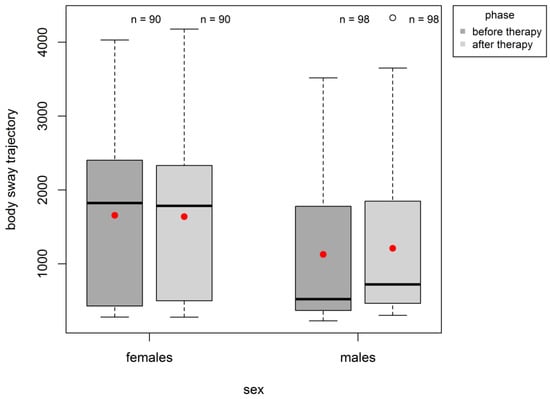
Figure 2.
The body sway trajectory in quiet stance with eyes opened.
The body sway trajectory in quiet stance with eyes closed was lower in male than in female patients, by 429.3 mm, p < 0.001 (Figure 3).
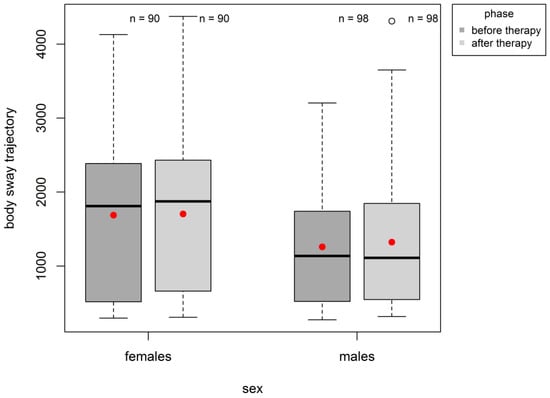
Figure 3.
The body sway trajectory in quiet stance with eyes closed.
The body sway trajectory in quiet stance with visual feedback was lower in male than in female patients, by 510.7 mm, p < 0.001 (Figure 4).
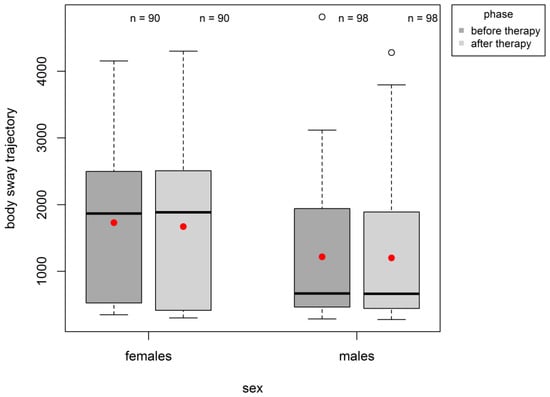
Figure 4.
The body sway trajectory in quiet stance with visual feedback.
3.2. Comparison of Results before and after the Therapy
The root mean square distance in quiet stance with visual feedback was lower by 5.8 mm after the therapy than before the therapy, p < 0.001 (Figure 5).
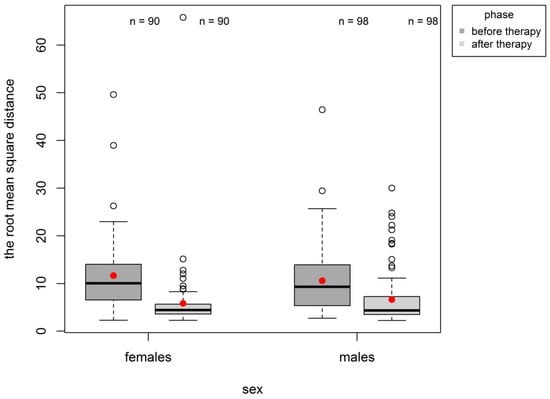
Figure 5.
The root mean square distance in quiet stance with visual feedback.
The root mean square distance in the mediolateral axis in quiet stance with visual feedback was lower by 2.2 mm after the therapy than before the therapy, p = 0.011 (Figure 6).
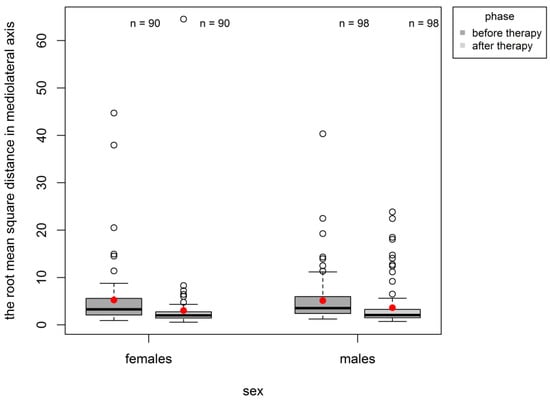
Figure 6.
The root mean square distance in the mediolateral axis in quiet stance with visual feedback.
The root mean square distance in the anteroposterior axis in quiet stance with visual feedback was lower by 4.9 mm after the therapy than before the therapy, p < 0.001 (Figure 7).
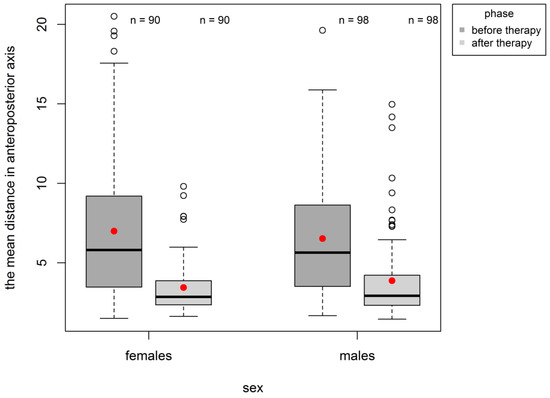
Figure 7.
The root mean square distance in the anteroposterior axis in quiet stance with visual feedback.
The time required to complete the dynamic reference training scene was slower by 7.0 after the therapy than before the therapy, p = 0.011 (Figure 8).
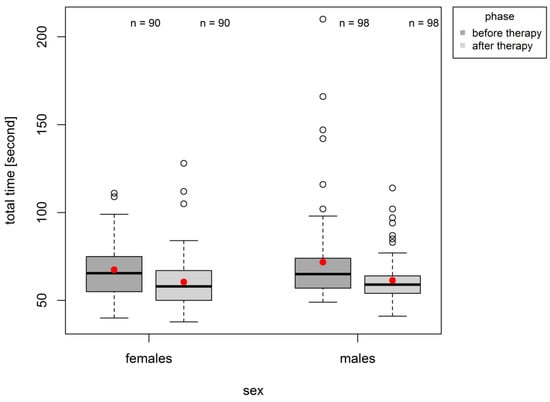
Figure 8.
The time required to complete dynamic reference training scene.
No statistically significant difference was observed in the other parameters.
4. Discussion
Koda et al. detected more severe impairments in balance when simultaneously deprived of visual and somatosensory inputs or during a backward destabilization in women than in men [15]. In our study, there was also a statistically significant difference in the body sway in quiet stance between male and female patients. The body sway was lower in men than in women in quiet stance with eyes opened, eyes closed, and with visual feedback. The average route mean square distance from the center did not differ statistically significantly between male and female participants. The ability to stand symmetrically was the same and no differences were observed in the anteroposterior axis, which is also affected by anthropometric parameters.
The previous study showed highly significant positive correlations with age, both with subjects’ eyes open and with their eyes closed, in healthy elderly adults [12]. In our investigation, no statistically significant effect was found regarding the patient’s age on the measured parameters. All patients had the same diagnosis of vertebral algic syndrome, and their age range was 55 ± 12 years for males and 52 ± 12 years for females. There might be a difference in more diverse age groups.
A statistically significant difference was observed between the results of the measurements before and after therapy. A statistically significant reduction in the root mean square distance was detected in the quiet stance with visual feedback. Furthermore, a slight statistically significant reduction in the time required to complete the reference dynamic training scene was observed. The root mean square parameter in quiet stance with visual feedback and the duration of the reference scene are the most meaningful parameters for detecting the differences of the measured values after the therapy compared to the state before the therapy, if we assume that the therapy has an effect.
The therapy was focused on training the response to visual stimuli, which may be the reason why, without visual feedback, there was no statistically significant improvement in standing balance. Low et al. also mentioned the positive effect of game-like training with audiovisual feedback using WBB on the improvement in dynamic balance, but not in tests aimed at standing balance without visual feedback [18].
Postural disorder in chronic back pain could be associated with plastic changes in the muscular representation of the trunk in the motor cortex [3,4]. Active repetitive game-like training could lead to positive changes in postural stability due to its effect on the neuroplasticity of the brain and motor learning. Our study has shown the immediate positive effect of motor learning after a single therapeutic unit. Regular balance training with audiovisual feedback could lead to a long-term decrease in postural disorders in patients with VAS. The limitations of our study are the absence of long-term monitoring of the patients, the absence of more detailed examination on the degree of their back pain and a small range of age categories. In future research, it is appropriate to compare the dependence of postural stability on the degree of back pain in vertebral algic syndrome, to compare postural stability in more diverse age groups and to evaluate the effect of long-term therapeutic intervention in patients with VAS.
5. Conclusions
The design of the therapy was accepted across the patient group without the occurrence of any undesirable side effects, so it may be a beneficial and safe therapy for patients with vertebral algic syndrome. The results of measurements in quiet stance and reference training scene with audiovisual feedback suggest that there is an improvement in the ability of patients to respond adequately to visual stimuli after a single therapeutic unit.
Author Contributions
Formal analysis, T.V. and L.Š.; Investigation, J.P. and K.H. (Kristýna Hoidekrová); Methodology, P.S. and J.J.; Supervision, K.H. (Karel Hána) and M.L.-G.; Writing—original draft, M.J. All authors have read and agreed to the published version of the manuscript.
Funding
This research received no external funding.
Institutional Review Board Statement
The study was conducted in accordance with the Declaration of Helsinki, and approved by the Ethics Committee of REHABILITATION CENTER KLADRUBY (date of approval 14 October 2020).
Informed Consent Statement
Informed consent was obtained from all subjects involved in the study. Written informed consent has been obtained from the patient(s) to publish this paper.
Data Availability Statement
The data presented in this study are available on request from the corresponding author. The data are not publicly available due to the privacy of probands.
Conflicts of Interest
The authors declare no conflict of interest. The funders had no role in the design of the study; in the collection, analyses, or interpretation of data; in the writing of the manuscript, or in the decision to publish the results.
References
- Ozcan Kahraman, B.; Kahraman, T.; Kalemci, O.; Salik Sengul, Y. Gender differences in postural control in people with nonspecific chronic low back pain. Gait Posture 2018, 64, 147–151. [Google Scholar] [CrossRef] [PubMed]
- Koch, C.; Hänsel, F. Non-Specific Low Back Pain and Postural Control During Quiet Standing-A Systematic Review. Front. Psychol. 2019, 10, 586. [Google Scholar] [CrossRef] [PubMed]
- Tsao, H.; Galea, M.P.; Hodges, P.W. Reorganization of the motor cortex is associated with postural control deficits in recurrent low back pain. Brain Advance Access published online on July 18. Brain 2008, 131, 2161–2171. [Google Scholar] [CrossRef] [PubMed] [Green Version]
- Goossens, N.; Janssens, L.; Caeyenberghs, K.; Albouy, G.; Brumagne, S. Differences in brain processing of proprioception related to postural control in patients with recurrent non-specific low back pain and healthy controls. NeuroImage Clin. 2019, 23, 101881. [Google Scholar] [CrossRef] [PubMed]
- Cyr, K.M.; Wilson, S.E.; Mehyar, F.; Sharma, N.K. Trunk Control Response to Unstable Seated Posture During Various Feedback Conditions in People with Chronic Low Back Pain. J. Allied Health 2019, 48, 54–60. [Google Scholar] [PubMed]
- Henschke, N.; Lorenz, E.; Pokora, R.; Michaleffc, A.Z.; Quartey, N.A.J.; Oliveira, V.C. Understanding cultural influences on back pain and back pain research. Best Pract. Res. Clin. Rheumatol. 2016, 30, 1037–1049. [Google Scholar] [CrossRef] [PubMed]
- Dufour, N.; Thamsborg, G.; Oefeldt, A.; Lundsgaard, C.; Stender, S. Treatment of chronic low back pain: A randomized, clinical trial comparing group-based multidisciplinary biopsychosocial rehabilitation and intensive individual therapist-assisted back muscle strengthening exercises. Spine 2010, 35, 469–476. [Google Scholar] [CrossRef] [PubMed]
- Warburton, D.E. The health benefits of active gaming: Separating the myths from the virtual reality. Curr. Cardiovasc. Risk Rep. 2013, 7, 251–255. [Google Scholar] [CrossRef]
- Searle, A.; Spink, M.; Ho, A.; Chuter, V. Exercise interventions for the treatment of chronic low back pain: A systematic review and meta-analysis of randomised controlled trials. Clin. Rehabil 2015, 29, 1155–1167. [Google Scholar] [CrossRef] [PubMed]
- Holmes, J.D.; Jenkins, M.E.; Johnson, A.M.; Hunt, M.A.; Clark, R.A. Validity of the Nintendo Wii® balance board for the assessment of standing balance in Parkinson’s disease. Clin. Rehabil 2013, 27, 361–366. [Google Scholar] [CrossRef] [PubMed]
- Kim, S.S.; Min, W.K.; Kim, J.H.; Lee, B.H. The effects of VR-based Wii fit yoga on physical function in middle-aged female LBP patients. J. Phys. Ther. Sci. 2014, 26, 549–552. [Google Scholar] [CrossRef] [PubMed] [Green Version]
- Komar, M.; Czerwosz, L. Physical Aspects of Posturography in Virtual Reality. Acta Phys. Pol. 2021, 139, 4. [Google Scholar] [CrossRef]
- Katona, J.; Ujbanyi, T.; Sziladi, G.; Kovari, A. Examine the effect of different web-based media on human brain waves. In Proceedings of the 8th IEEE International Conference on Cognitive Infocommunications (CogInfoCom), Debrecen, Hungary, 11–14 September 2017; pp. 000407–000412. [Google Scholar]
- Kovari, A.; Katona, J.; Costescu, C. Quantitative Quantitative analysis of relationship between visual attention and eye-hand coordination. Acta Polytech. Hung 2020, 17, 77–95. [Google Scholar] [CrossRef]
- Koda, Y.; Yamada, K.; Motomura, H.; Sunami, K. Periodic alternating nystagmus induced by light stimulation: A case report and review of the literature. Otolaryngol. Case Rep. 2021, 21, 100347. [Google Scholar] [CrossRef]
- Accornero, N.; Capozza, M.; Rinalduzzi, S.; Manfredi, G.W. Clinical multisegmental posturography: Age-related changes in stance control. Electroencephalogr. Clin. Neurophysiol. Electromyogr. Mot. Control 1997, 105, 213–219. [Google Scholar] [CrossRef]
- Wolfson, L.; Whipple, R.; Derby, C.A.; Amerman, P.; Nashner, L. Gender differences in the balance of healthy elderly as demonstrated by dynamic posturography. J. Gerontol. 1994, 49, M160–M167. [Google Scholar] [CrossRef] [PubMed]
- MSc, G.C.; ClinDocPT, D.T.; MSc, A.L.; Hewitt, J. Is Nintendo Wii an effective intervention for individuals with stroke? A systematic review and meta-analysis. Physiotherapy 2015, 101, e904–e905. [Google Scholar]
- Clark, R.A.; Mentiplay, B.F.; Pua, Y.H.; Bower, K.J. Reliability and validity of the Wii Balance Board for assessment of standing balance: A systematic review. Gait Posture 2018, 61, 40–54. [Google Scholar] [CrossRef] [PubMed]
- Bartlett, H.L.; Ting, L.H.; Bingham, J.T. Accuracy of force and center of pressure measures of the Wii Balance Board. Gait Posture 2014, 39, 224–228. [Google Scholar] [CrossRef] [PubMed] [Green Version]
Publisher’s Note: MDPI stays neutral with regard to jurisdictional claims in published maps and institutional affiliations. |
© 2022 by the authors. Licensee MDPI, Basel, Switzerland. This article is an open access article distributed under the terms and conditions of the Creative Commons Attribution (CC BY) license (https://creativecommons.org/licenses/by/4.0/).